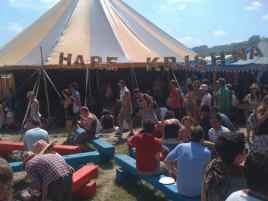ISKCON Remains Prominent at 40th Glastonbury, UK
By Gaura Hari Das | Jul 08, 2010

June 2010 marked the 40th anniversary of Europe’s largest green field music festival. Glastonbury Festival of Contemporary Performing Arts was started from humble beginnings four decades ago and attracted mostly those immersed in the hippy culture and those seeking an alternate lifestyle. Back then, as it still is now, music was the inspiration and the main medium for conveying new ideas, concepts and emotions. As the British nation changed and evolved so too did the Glastonbury Festival. Surprisingly today in the midst of an economic recession, Glastonbury has now thrived as a monstrous money making event. The biggest names in world music are there every year and it is still as popular as it was in the past. However the people coming now are different to those who attended many years ago. The majority of festival goers at the Glastonbury Festival in 2010 are students and workers paying almost £200 for their ticket using their credit card online. Glastonbury has become a weekend of adventure for those living regular lives across Britain. Some are seekers or maybe just hoping to stumble on a new way of living, but most are looking for no more than a break from their regular routine.
However some things always stand the test of time, and if you attended Glastonbury in 1979, or in 2010 you will still see the Hare Krishna devotees wandering around the site singing Krishna kirtana.
Security around the festival is tight with a huge fence and hundreds of security and police personnel on site. So if you don’t have a ticket you don’t get in. The heavy security measures are in response to having over 150,000 extra people gatecrash the festival without prepaid tickets some years ago. Tickets for the festival are now in high demand and usually sell out on the Internet within an hour of being released. The organisers of the festival provide Iskcon with 12 free tickets, although some devotees purchase their own tickets at a cost of £195 in order to help out.
Iskcon has been involved with the festival since its early days and the Hare Krishna devotees are so much part of the festival that there is no question of them not being present. Strong relationships have been built with traders, security, and others working on and attending the festival. However the area and number of tickets being issued to the devotees has been reduced over the years to make way for other traders who pay large fees for a small spot at the festival. Unlike most, the Hare Krsna Tent is not there to make money but rather to provide a spiritual oasis to what can be a hectic and intense environment.
There is nowhere else on site where people can get a free meal and keep coming back for more. Parasurama and his team cooked continually for three days to provide festival goers with free meals throughout the day and late into the night. Devotees took turns to serve out the prasadam. Even young Savitri, who went with her mother, helped by serving out honey on top of the morning breakfast of porridge with fruits. “There is a great family atmosphere here” Raghunatha Dasa commented. “Everyone gets involved especially the youth and the children”
As people sat enjoying their meal, melodious kirtana played from a small stage at the back of the tent. Jayananda who came from Ireland with his sister Sita and father Manu, led kirtana while Jaggi Suta played mrdanga. Later Madhava took to the stage with Gopal as his mrdanga player, and a style of kirtana which has become famous at kirtana festivals worldwide was now thrilling the audience at Glastonbury. Many who were experiencing kirtana for the first time stayed for many hours. Those who were not eating clapped their hands or danced in front of the decorated alter, which housed the large deities of Gaura Nitai.
Occasionally Giridhari Prabhu, who heads the festival team in the UK, would host lively question and answer sessions. Maha Visnu Swami would also speak in between kirtana, explaining the philosophy and lifestyle of the Hare Krishna movement. As well as Barat Natyam, the small stage show included some magic tricks by Parasurama who has more tricks up his sleeve than a regular chef.
As Mohan adjusted the sound at the mixing desk he explained; “It would be nice to have more kirtana singers and performers as well as other devotees to speak to the guests in our tent, but we just don’t have enough tickets to give out to everyone. Its a real shame because there are many devotees who were eager to help in different ways, but we can’t get them in.”
Moksa Laxmi and Gandharvika sat by a small book table near the tent which also had incense and blankets for those who came unprepared for the chill of the British summer nights. For 4 days the small team of devotees did what they have been doing successfully for decades now.
Many people commented favourably about the Hare Krishna Tent. Glyn from Bristol said, “I’ve been coming here for years now and you guys save me each year with your food.” Mark from Canada revealed how he spent two days listening to the kirtanas. “I even got up and danced a little” he added with a smile.
While the organizers of the Glastonbury festival continue to spin what is now an entertainment machine worth millions of pounds, the Hare Krishna devotees continue to share and care for those at the festival in a way very few others can. Greatly appreciated, these simply acts of sharing food, kirtana, and a little knowledge will surely see devotees participating at the Glastonbury festival for at least another 40 years to come.















